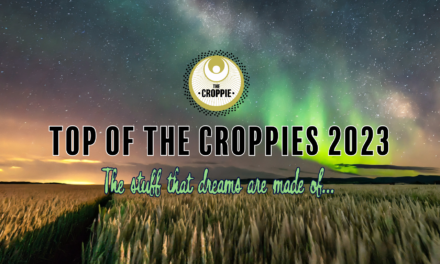
Glyphosate Poisoned My Camel!

Aren’t we all dim, unintelligent dupes, eagerly rushing into crop circles to line the pockets of the sinister cabal running the show from their luxurious mansions. Aren’t we all so thick we uncritically believe aliens make crop circles. Well, apparently we are, on both accounts. But let’s not worry, from the other side of the globe Hamish Jacobs is always around to make us think more critically. Well, he would (in his dreams) if he hadn’t blocked everyone he probably wanted to speak to. However, it seems such tactics have failed for the intolerant, bitter old scrote as he’s now attempting to scare circle makers and croppies from the fields. Not content with talking shite about how it will be ‘easier’ for makers to be caught in 2024, he’s now telling everyone that crop circles are hazardous to their health because of one particular herbicide and crop desiccant: glyphosate.
Here’s what the happy chap had to say:


So, do such claims of teddy bears wanting to avoid the fields of Wiltshire stack up? Will croppies be sat in wheelchairs or slowly rotting from the inside because they’ve spent a couple of hours in a field of barley or wheat?
As ever, the answer is a ‘maybe’, though the weight of evidence comes down with those who suggest the glyphosate is of low toxicity. America’s National Pesticide Information Center is based at Oregon State University. It had this to say on glyphosate:
Pure glyphosate is low in toxicity, but products usually contain other ingredients that help the glyphosate get into the plants. The other ingredients in the product can make the product more toxic. Products containing glyphosate may cause eye or skin irritation. People who breathed in spray mist from products containing glyphosate felt irritation in their nose and throat. Swallowing products with glyphosate can cause increased saliva, burns in the mouth and throat, nausea, vomiting, and diarrhea. Fatalities have been reported in cases of intentional ingestion…
Animal and human studies were evaluated by regulatory agencies in the USA, Canada, Japan, Australia, and the European Union, as well as the Joint Meeting on Pesticide Residues of the United Nations and World Health Organization (WHO). These agencies looked at cancer rates in humans and studies where laboratory animals were fed high doses of glyphosate. Based on these studies, they determined that glyphosate is not likely to be carcinogenic. However, a committee of scientists working for the International Agency for Research on Cancer of the WHO evaluated fewer studies and reported that glyphosate is probably carcinogenic.
Has anyone studied non-cancer effects from long-term exposure to glyphosate?
Long-term feeding studies in animals were assessed by the U.S. Environmental Protection Agency (EPA) and other regulatory authorities. Based on these evaluations, they found there is no evidence glyphosate is toxic to the nervous or immune systems. They also found it is not a developmental or reproductive toxin.
Source: http://npic.orst.edu/factsheets/glyphogen.html#:~:text=Glyphosate%20is%20an%20herbicide.,in%20the%20U.S.%20in%201974.
Not convinced? The United States Environmental Protection Agency states:
EPA scientists performed an independent evaluation of available data for glyphosate and found:
No risks of concern to human health from current uses of glyphosate.
No indication that children are more sensitive to glyphosate.
No evidence that glyphosate causes cancer in humans.
EPA did not agree with the International Agency for Research on Cancer (IARC) conclusion that glyphosate is “probably carcinogenic to humans.” EPA considered a significantly more extensive and relevant dataset than the International Agency on the Research for Cancer (IARC). EPA’s database includes studies submitted to support registration of glyphosate and studies EPA identified in the open literature. For instance, IARC only considered eight animal carcinogenicity studies while EPA used 15 acceptable carcinogenicity studies. EPA does not agree with IARC’s conclusion that glyphosate is “probably carcinogenic to humans.”
EPA’s cancer classification is consistent with other international expert panels and regulatory authorities, including the Canadian Pest Management Regulatory Agency, Australian Pesticide and Veterinary Medicines Authority, European Food Safety Authority, European Chemicals Agency, German Federal Institute for Occupational Safety and Health, New Zealand Environmental Protection Authority, and the Food Safety Commission of Japan and the Joint Food and Agriculture Organization/World Health Organization (FAO/WHO) Meeting on Pesticide Residues (JMPR).
But those official organisations would say that, wouldn’t they?
The Croppie isn’t the place to go into the history of various environmental protection agencies getting things right or wrong. If such things interest you then Google is your friend, though it is worth mentioning that the use of glyphosate is to be reviewed in Britain by December 2025, though we don’t expect to see any changes.
Ultimately, let’s remember one thing. We take risks in our daily lives, from crossing the road to getting out of the shower. What matters is how we manage these risks and whether we believe they are worth taking. As croppies, we face a choice every time we go into a crop circle. We allow ourselves to enter an environment where the crop has typically been sprayed with herbicide at some point or another in its life cycle. (Sensible individuals would probably shy from entering a field that has been recently sprayed. We’ve been and done that and it wasn’t a particularly pleasant experience.) However, when we assess that risk, do we believe the scientific consensus or the word of a bitter old camel in Queensland who hates crop circles and wants to do all he can to deter people from going into the fields?





